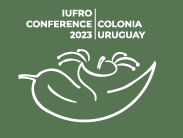Rooting screening in Eucalyptus dunnii clones
inverting the order in a clonal selection process
DOI:
https://doi.org/10.31285/AGRO.27.1300Abstract
One of the main goals of a tree breeding program is to increase forest productivity, adaptation and profitability of forest plantations. Eucalyptus dunnii is a main species used for pulp production in Uruguay. Montes del Plata (MdP) is one of the largest forest companies in Uruguay and has been focused on the development, testing and deployment of E. dunnii clones to establish commercial plantations in Uruguay. MdP clonal strategy starts with the generation, testing and selection of families (Open-pollination and|or Control-pollination) with a breeding population with a wide genetic diversity in order to have a sustainable clonal program. Seeds from the best families are used for clonal development in a two-phase strategy that takes place in the company research nursery. On the first phase, all potential clones are screened for rooting and only the ones that root more than 60% go to the next phase. An average of 4,000 E. dunnii clones is evaluated every year, and 200 clones overpass 60% rooting threshold. This represents 5% of screened clones. The second phase is to produce plants in the nursey for the establishment of clonal trials in field, and, based on the performance, to select the candidate clones for deployment and breeding. Although the strategy and the breeding program are relatively young, promising results are seen. In the last 6 years, 1,225 E. dunnii clones developed by this rooting strategy were successfully established in clonal field trials. For species of Eucalyptus that have an undesirable trait of difficulty-to-root (recalcitrance), the screening of genotypes by rooting allows to establish in field testing clones with efficient clonal propagation. This way, the measurement and wood sampling in field trials is funnelled to clones that, if selected, could be scaled to clonal plantations.
Downloads

Downloads
Published
How to Cite
Issue
Section
License
Copyright (c) 2023 Agrociencia Uruguay

This work is licensed under a Creative Commons Attribution 4.0 International License.
| Article metrics | |
|---|---|
| Abstract views | |
| Galley vies | |
| PDF Views | |
| HTML views | |
| Other views | |















